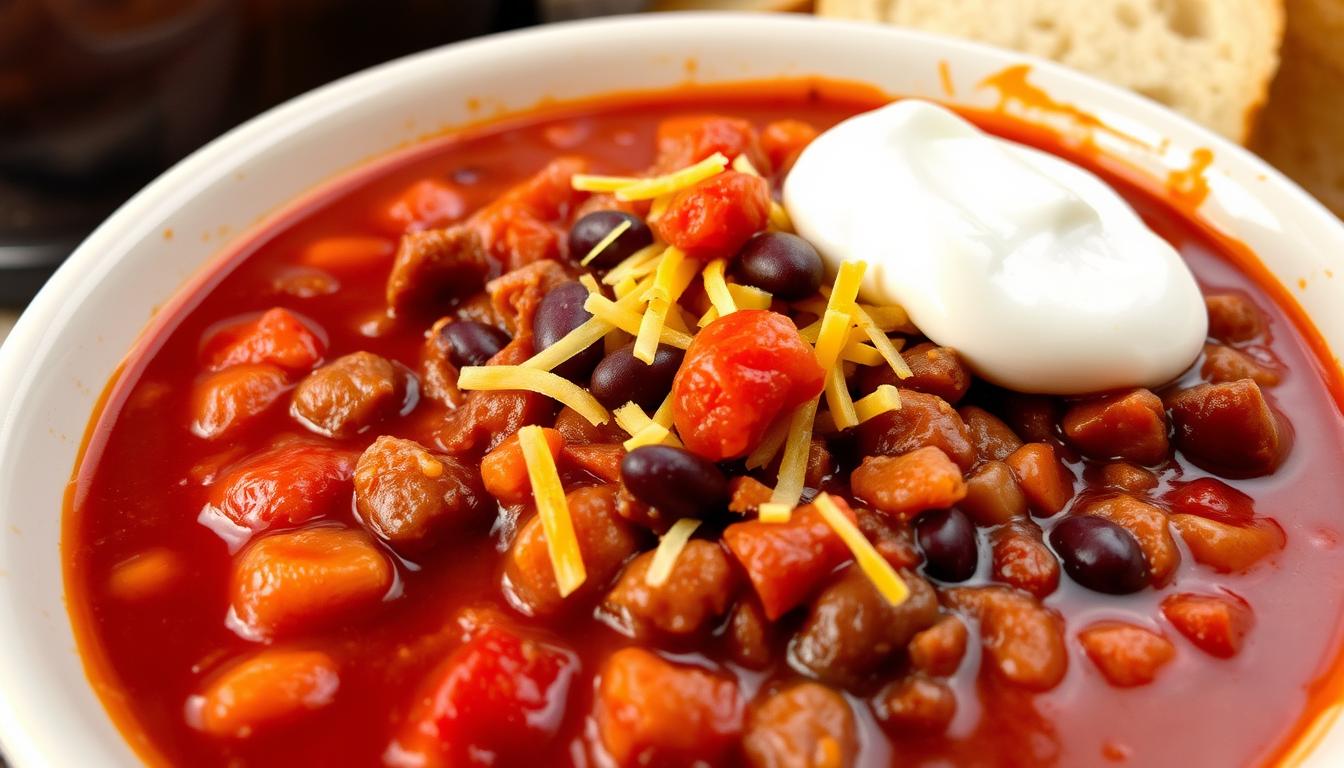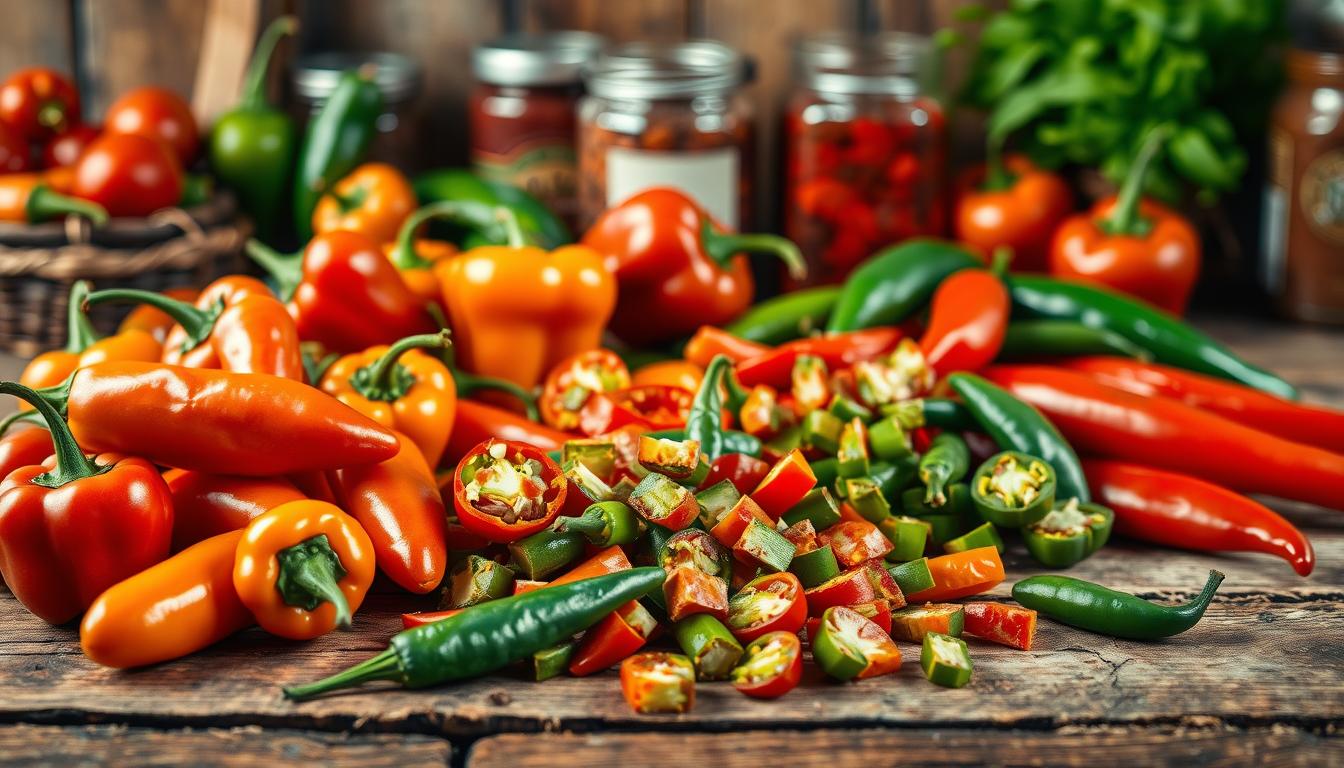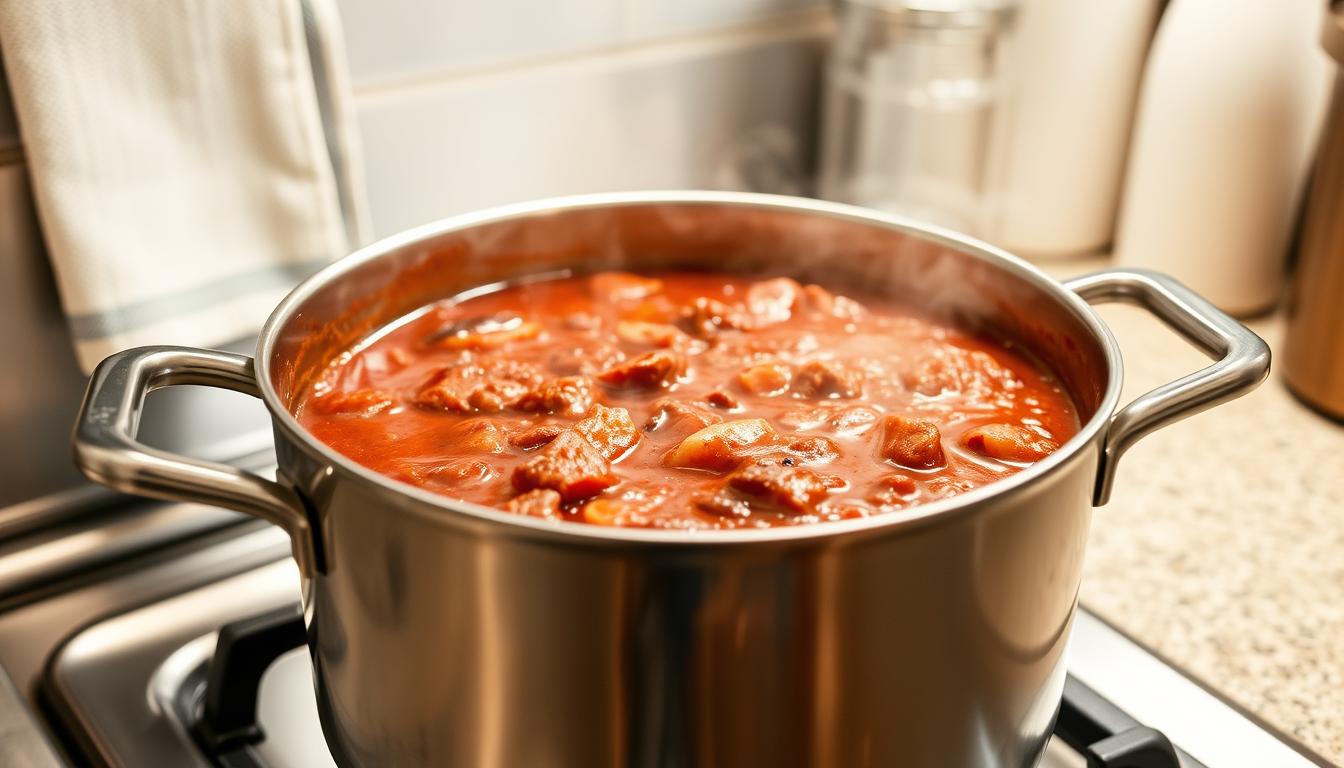There’s nothing quite like a warm, comforting bowl of homemade chili on a chilly evening. A great chili recipe can become a staple in any household. We’re excited to share our ultimate version with you.

This recipe will take you on a journey through the history of chili. We’ll explore its origins and evolution. We’ll also dive into the essential ingredients and cooking techniques that make our best chili recipe stand out.
Key Takeaways
- Discover the secret to making the perfect homemade chili
- Learn about the history and cultural significance of chili
- Explore the essential ingredients for a great chili recipe
- Master the cooking techniques to make your chili stand out
- Get tips on customizing your chili to suit your taste
The Rich History of Chili: America’s Beloved Comfort Food
Chili has a long history in America, becoming a favorite comfort food. Its journey from simple beginnings to a classic dish is interesting. It shows how different cultures and cooking styles come together.
Origins of Chili Con Carne
Chili con carne, a staple in American cuisine, started in the southern United States, especially in Texas. Early chili was made with meat, chili peppers, and sometimes beans. It was influenced by Mexican food, with “chili con carne” meaning “chili with meat” in Spanish.
The evolution of chili con carne was shaped by the cultural mix of the areas where it was enjoyed. As people added their own touches, the recipe grew, leading to the many chili types we see today.
How Chili Became an American Staple
As people moved, they brought their chili recipes with them, changing them to fit local tastes. Chili cook-offs became a big part of American culture. Its flexibility, whether for casual get-togethers or a warm meal on a chilly day, made it a favorite.
Now, chili is loved all over the country, with each region having its own version. From Texas-style chili to the bean-filled bowls of the Midwest, it’s a key part of American food culture.
What Makes a Perfect Chili Recipe?
The secret to a mouth-watering chili is its balance of flavors and consistency. A well-crafted chili recipe is a symphony of tastes and textures. It creates a dish that’s both satisfying and memorable.
The Balance of Flavors
Achieving the perfect balance of flavors in chili is crucial. It involves combining ingredients that provide sweetness, acidity, spiciness, and depth. Chili peppers are a fundamental component, offering both heat and flavor. The type and amount of peppers used can significantly impact the overall taste.
- Use a mix of chili peppers for complexity.
- Balance spiciness with sweetness from ingredients like tomatoes or sugar.
- Add acidity with a splash of vinegar or citrus.
As
“The best chili is one that has been simmered to perfection, allowing the flavors to meld together.”
This quote highlights the importance of cooking time in developing the flavor profile of chili.
Texture and Consistency
The texture and consistency of chili are just as important as its flavor. A good chili should have a thick, hearty consistency that coats the spoon.
Edit
Delete
To achieve the right consistency, consider the following:
- Use a mixture of finely chopped and larger ingredients for texture variety.
- Simmer the chili for an extended period to reduce the liquid and thicken the mixture.
- Avoid over-reducing, which can make the chili too thick and sticky.
By focusing on the balance of flavors and achieving the right chili texture, you can create a perfect chili recipe. It’s sure to please even the most discerning palates.
Essential Ingredients for Award-Winning Chili
To make a truly exceptional chili, it’s crucial to select the right ingredients. These ingredients will elevate its taste and texture. The quality and combination of these core ingredients are what set a great chili apart from an average one.
Choosing the Right Meat
The type of meat used in chili can significantly impact its flavor profile. The choice between different meats can alter the character of the dish entirely.
Ground Beef vs. Chunks
Ground beef is a popular choice for chili because it blends well with other ingredients. Chunks of beef, on the other hand, provide a heartier texture. The choice between ground and chunks depends on personal preference and the desired consistency of the chili.
Alternative Meats to Consider
While beef is traditional, other meats like pork, turkey, or even venison can add unique flavors to chili. Experimenting with different meats can help in finding the perfect flavor profile for your award-winning chili.
The Perfect Blend of Chili Peppers
Chili peppers are the backbone of any chili recipe, providing the heat and a significant portion of the flavor. Selecting the right blend of peppers is crucial.
Fresh vs. Dried Peppers
Both fresh and dried peppers have their advantages. Fresh peppers can add a brighter, more vibrant flavor. Dried peppers provide a deeper, more complex heat. A combination of both can create a well-rounded flavor profile.
Building Heat Levels
The heat level in chili is subjective and can be adjusted according to preference. By selecting different types of peppers or varying their quantities, you can fine-tune the heat to your liking. Understanding the Scoville scale can help in fine-tuning the heat to your liking.
Beans: To Add or Not to Add?
The debate over whether to include beans in chili is ongoing. Beans can add texture, fiber, and additional flavor. However, traditionalists may prefer to keep their chili bean-free. The decision is largely a matter of personal preference.
Secret Flavor Boosters
Beyond the main ingredients, certain secret flavor boosters can elevate your chili to the next level. These can include a variety of spices, herbs, and other unexpected ingredients.
Unexpected Ingredients That Work
Ingredients like coffee, chocolate, or even bacon can add depth and complexity to chili. These ingredients might seem unusual, but they can enhance the overall flavor profile.
Balancing Sweet and Savory
Achieving a balance between sweet and savory flavors is key to a well-rounded chili. Ingredients like brown sugar or tomatoes can add sweetness. Savory elements come from meats, spices, and certain types of peppers.
Equipment You’ll Need
The right cooking equipment is key to making delicious chili. The right tools make cooking easier and improve your chili’s taste and texture.
Pot Selection: Dutch Oven vs. Slow Cooker
Choosing between a Dutch oven and a slow cooker depends on your cooking style. A Dutch oven is great for those who like to cook hands-on. It lets you brown meat and sauté veggies before slow cooking.
A slow cooker is best for busy people. It cooks your chili for hours without needing you to watch it.
Essential Tools for Preparation
You’ll also need some basic tools to prepare your chili. A large cutting board is essential for chopping ingredients. A sharp knife helps with precise cuts. And a wooden spoon or spatula is perfect for stirring.
Having these tools ready makes preparing your chili easier and faster.
The Ultimate Chili Recipe Step-by-Step
To make the best chili, follow this guide from start to finish. Making great homemade chili takes careful prep, knowing each ingredient’s role, and using the right cooking methods. These steps help bring out the flavors.
Preparing Your Ingredients
The first step is to prepare your ingredients. Chop onions, mince garlic, and dice your meat or protein. For an easy chili recipe, have all ingredients ready before cooking.
- Chop 1 large onion and 3 cloves of garlic.
- Dice 1 pound of your chosen meat (beef, turkey, or vegetarian options).
- Open a can of diced tomatoes and a can of beans (if using).
Building the Base Flavors
Creating the base flavors is key for a rich chili. Start by sautéing onions and garlic until soft. Then, cook your meat until it’s browned evenly.
Add chili peppers, cumin, and oregano to enhance flavor. The right mix of spices is crucial for a great homemade chili.
Cooking Techniques for Maximum Flavor
The cooking method greatly affects your chili’s taste. Here are some chili cooking techniques to try:
| Cooking Method | Benefits | Time Required |
| Dutch Oven | Even heating, rich flavor | 2-3 hours |
| Slow Cooker | Convenient, hands-off | 6-8 hours |
| Stovetop | Quick, easy to adjust seasoning | 1-2 hours |
How to Know When Your Chili is Done
To know if your chili is done, check the flavor, texture, and consistency. It should be thick and have a rich flavor. Let it simmer to meld the flavors.
Taste it and adjust the seasoning as needed. If it’s too thick, add water. If too thin, simmer longer.
By following these steps and techniques, you’ll make a delicious, homemade chili that everyone will love.
Customizing Your Chili Recipe for Any Taste
Chili is great because you can change it to suit your taste. You can make it vegetarian or vegan, adjust the spice, or try different regional styles. There’s a chili recipe for everyone.
Vegetarian and Vegan Adaptations
Vegetarians and vegans can enjoy chili just as much as meat-eaters. Use plant-based proteins like textured vegetable protein, tempeh, or seitan instead of ground beef. Beans like black, kidney, or pinto beans add protein and fiber. Use vegetable broth to keep it vegan.
Tip: Roasting vegetables like bell peppers, zucchini, or eggplant adds a rich flavor to your chili.
Spice Level Adjustments
You can make chili as spicy or mild as you like. For a milder taste, cut down or skip the jalapenos or serrano peppers. For more heat, add more peppers or try hotter ones like habaneros or ghost peppers.
Regional Variations
Chili varies a lot by region, each with its own taste. Here are a few examples:
| Region | Characteristics |
| Texas | Beef is the main focus, with a simple yet deep flavor. |
| Cincinnati | This version is served over spaghetti, topped with cheese, onions, and beans. |
| New Mexico | Green chilies are key, roasted and chopped for a bright, smoky taste. |
Texas-Style Chili
Texas chili uses big chunks of beef for a rich, beefy flavor.
Cincinnati Chili
Cincinnati chili is unique, served over spaghetti with cheese, onions, and beans.
New Mexico Green Chili
New Mexico chili is known for its roasted green chilies, offering a refreshing, spicy taste.
Dietary Modifications
For low-carb or keto diets, reduce or remove beans and use more protein like ground beef or turkey. Add avocado or sour cream for healthy fats.

With a few tweaks, chili can fit your dietary needs without losing flavor.
Perfect Pairings and Toppings for Your Chili
Make your chili unforgettable with the right toppings and pairings. Chili is versatile, so you can make it your own.
Classic Chili Toppings
The right toppings can make your chili amazing. Here are some favorites:
Cheese Options
Melted cheese adds a creamy texture. Try cheddar, Monterey Jack, or pepper jack for a kick.
Fresh Additions
Fresh elements like diced onions, chopped cilantro, or sliced jalapeños add texture and flavor.
Creamy Elements
Sour cream or Greek yogurt can cool down the heat and add tanginess.
Side Dishes That Complement Chili
The right side dish can enhance your chili. Try these options:
- Cornbread: A classic pairing that is both traditional and delicious.
- Salad: A fresh green salad can provide a nice contrast to the hearty chili.
- Roasted Vegetables: Roasted vegetables like carrots or Brussels sprouts can add a nice depth of flavor.
Beverage Pairings
The right drink can enhance your chili-eating experience. Here are some pairing suggestions:
| Beverage | Description |
| Craft Beer | A hoppy IPA or a malty amber ale can complement the complex flavors of chili. |
| Red Wine | A robust red wine like a Cabernet Sauvignon or Syrah/Shiraz pairs well with chili. |
| Iced Tea | For a non-alcoholic option, a glass of iced tea, sweetened or unsweetened, can be refreshing. |
Storage, Freezing, and Reheating Your Chili
Chili is even better the next day. With the right storage and reheating, you can enjoy it for days. This makes chili a favorite in many homes. Let’s look at why it’s better with time, how to store it, and the best ways to reheat.
Why Chili Tastes Better the Next Day
Chili gets better with time. The flavors mix, making it richer and more complex. Julia Child once said, “The only time to eat diet food is while you’re waiting for the steak to cook.” Waiting for chili is worth it, as it lets the flavors blend.
“The secret to great chili is letting it rest. The flavors need time to meld together, and the longer it sits, the better it gets.”
— Anonymous Chili Enthusiast
Proper Storage Methods
To keep chili fresh, store it right. Cool it down quickly, then put it in an airtight container. You can store it in the fridge for 3-4 days. For longer, freeze it. Use airtight containers or bags, pressing out air before sealing. Label them with date and contents.
- Cool chili quickly to prevent bacterial growth.
- Use airtight containers for refrigeration.
- Label freezer containers with date and contents.
Reheating Without Losing Flavor
Reheat chili gently to keep flavors and textures. Heat it on the stovetop over low heat, stirring often. You can also use the microwave, covering it and stirring every 30 seconds. If it’s too thick, add a bit of water or broth.

Conclusion: Mastering the Art of Homemade Chili
Now you know the secrets to making perfect homemade chili. With the right mix of flavors, texture, and consistency, you’re on your way. This recipe will become a favorite in your home, no matter your cooking level.
Follow the steps in this article to make a delicious homemade chili. It will impress even the most finicky eaters. So, get creative and try new ingredients and flavors to make your chili stand out.
With time and practice, you’ll become a pro at making homemade chili. Your friends and family will ask for more. So, don’t hesitate to experiment and make this recipe your own. Mastering chili is a journey worth taking.
FAQ
What is the best type of meat to use for chili?
Ground beef is a classic choice. But, you can also use chunks of beef, turkey, or even beans or tofu. The key is to pick a meat that stays tender during cooking.
Can I make chili in a slow cooker?
Yes, chili is perfect for slow cookers. Brown the meat and cook the onions and garlic first. Then, put everything in the slow cooker and cook on low for 6-8 hours.
How do I adjust the spice level in my chili?
To change the spice, add more or less chili peppers or hot sauce. Adding sour cream or yogurt can also help cool down the heat.
Can I freeze chili?
Yes, chili freezes well. Cool it down completely, then put it in an airtight container or freezer bag. To eat it, thaw and reheat.
What are some common toppings for chili?
Popular toppings include shredded cheese, sour cream, and diced onions. Crushed tortilla chips, fresh cilantro, diced tomatoes, or paprika are also great.
How do I know when my chili is done?
Chili is ready when the flavors blend well and the meat is tender. Taste and adjust the seasoning as needed.
Can I make chili without beans?
Yes, you can make chili without beans. Some styles, like Texas-style, don’t have beans. Just leave out the beans or use diced potatoes or corn instead.
What’s the best way to reheat chili?
To reheat chili, warm it over low-medium heat, stirring now and then, until it’s hot. You can also use the microwave or oven.
Can I customize chili to suit dietary restrictions?
Yes, chili can be tailored for different diets. For a vegetarian or vegan version, use plant-based ingredients. For gluten-free or low-carb diets, adjust the ingredients accordingly.